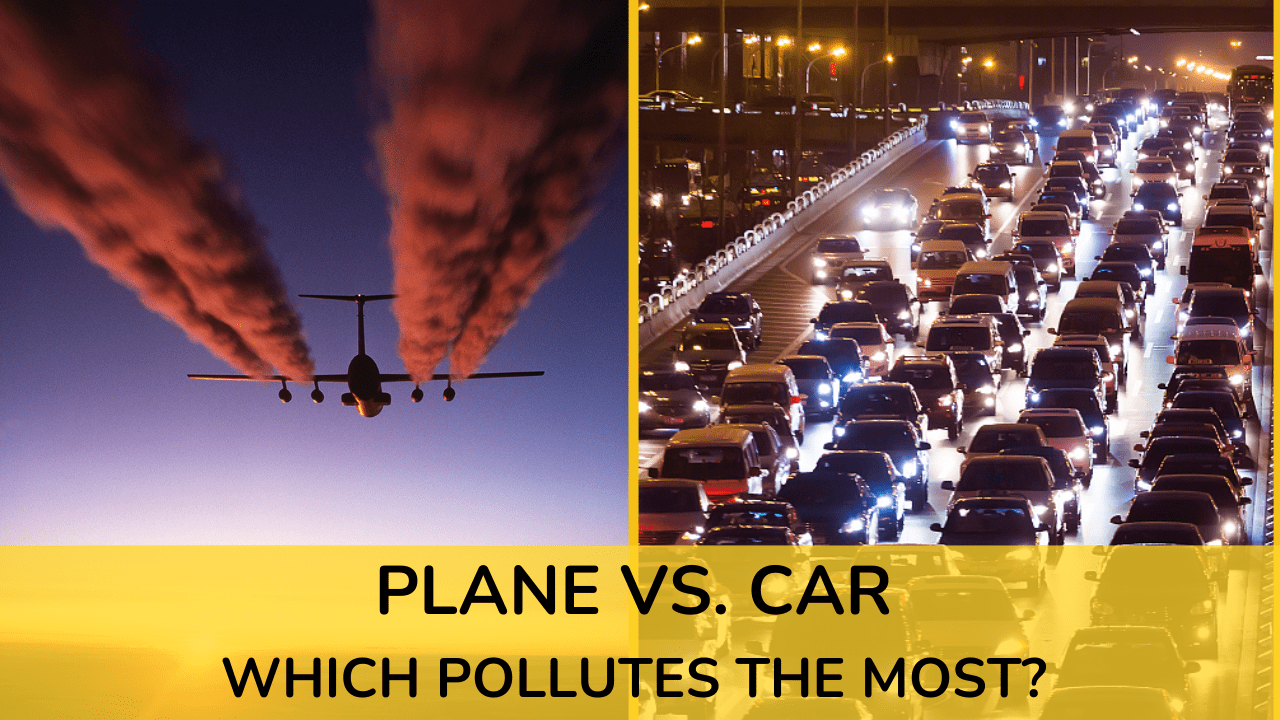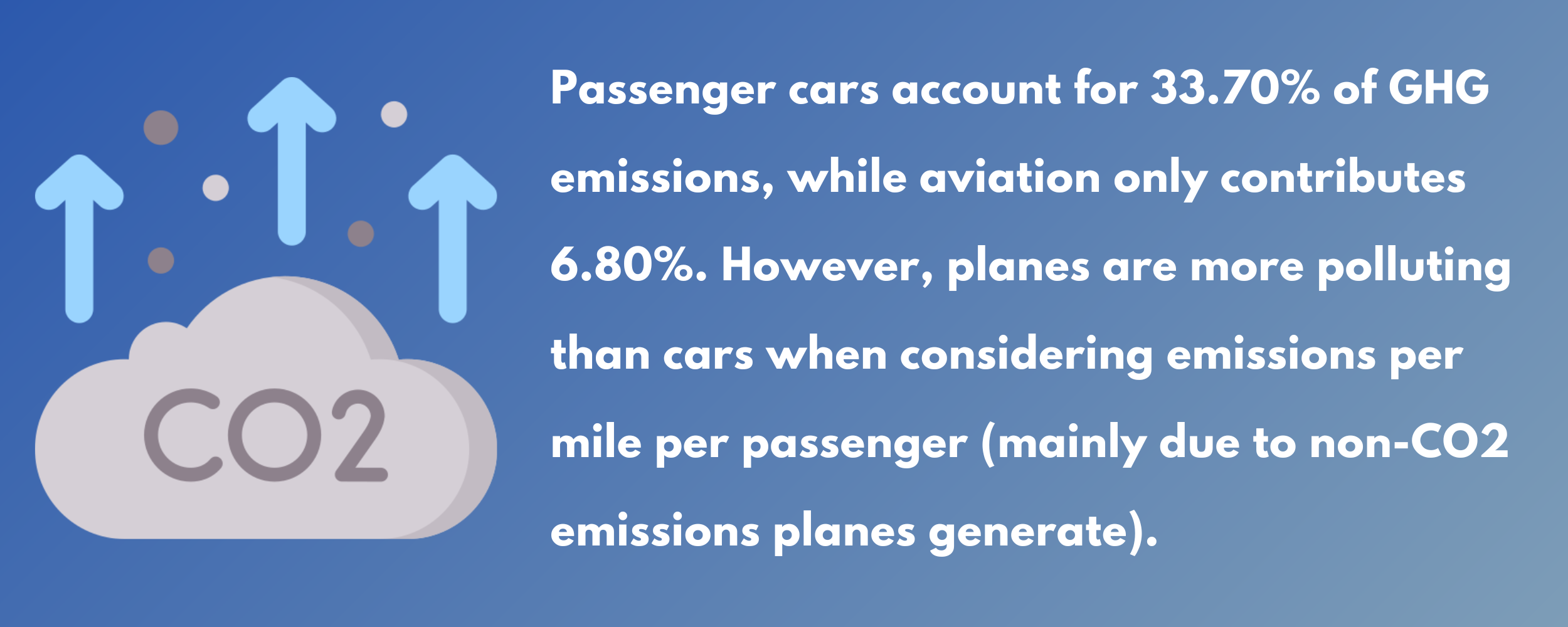
It might seem obvious that a jet-powered plane pollutes more than a humble passenger car. After all, the average plane is 100 times bigger than a car, carries 20-50 times more passengers and burns through approximately 750 gallons of fuel per hour. However, when we start to interrogate the data and consider the overall contribution to greenhouse gas emissions, the picture is somewhat different.
According to the Environmental Protection Agency’s 2020 data, the transportation sector (cars, trucks, ships, trains, and planes) was the number 1 contributor of greenhouse gas emissions in the U.S., accounting for 27%. But how much do planes and cars contribute to this total? Read on to find out.

What Is Defined As An Emission?
In the context of climate change, emissions are the greenhouse gases that are produced as a result of human activities, namely: manufacturing, electricity generation, commerce, housing, agriculture and transportation.
Carbon dioxide is recognised as the main driver of global climate change as it is the most dominant greenhouse gas, accounting for 79% of emissions in the U.S. in 2020. Other gases, although produced in much smaller quantities, also play a significant role in global warming: methane (11% of total emissions), nitrous oxide (7%) and HFCs, PFCs, SF6 and NF3 (3%).
Overall, the U.S. emitted almost 6 billion tons of greenhouse gases (CO2e) in 2020, making it the second largest emitter behind China. In fact, these 2 countries, together with just 5 other emitters (India, the European Union, Indonesia, the Russian Federation and Brazil), were responsible for approximately 50% of global greenhouse gas emissions that year.
How Much Pollution Do Cars Generate?
When we drill down into the data of U.S. greenhouse gas emissions, we see that passenger cars account for 33.7% of the total GHG gases produced. If we factor in all other road vehicles (light, medium and heavy trucks, buses and motorcycles), the total increases to 75.3%. This might be surprising given that aviation is often cited as the most polluting mode of transportation however, on a macro level, this is simply not the case.
Cars exist in far higher numbers than planes: it is estimated that there are 1.54 billion cars in the world and by comparison, only around 25,000 passenger planes. Moreover, the rate of car ownership in the U.S. is exceptionally high at 93%, versus a global average of 18%.
But how do cars perform on a single unit basis? Let us examine the key metrics:
- A typical passenger car emits 348 grams of production-weighted CO2 per mile
- Based on an average annual mileage in the U.S. of 14,263, a typical car emits 4,963 kg or about 5 metric tons of CO2 every year
- In order to be able to make a meaningful comparison between cars and planes, we need to consider the CO2 emitted per passenger per mile. Assuming that the average occupancy for a car is 1.5, this calculates to approximately 232 grams of CO2 emitted per mile per passenger.
How Do Planes Compare To Cars?
Aviation, including general, military and commercial planes, accounts for only 6.8% of greenhouse gas emissions, about 1/5th of what passenger cars produce or 1/10th of all road vehicles. Not only are there substantially fewer planes in circulation than cars, but they are also used far less frequently and by a much smaller subsection of the population.
In terms of commercial air travel, it is estimated that only 2% to 4% of the global population flew internationally in 2018. In the U.S. the number is higher, with 38% of Americans taking at least 1 flight in 2021 but only 8% flying 5 or more times. This elite group of frequent flyers is responsible for up to 50% of the total aviation emissions, which highlights that planes are an incredibly energy intensive way to travel.
But just how much pollution do individual planes produce in direct comparison to cars? Let us review the CO2 emitted per mile per passenger:
- Domestic flights emit 207 gm of CO2 per mile per passenger
- Long haul flights emit 159 gm of CO2 per mile per passenger
When planes fly long distances with a high occupancy rate, they are more fuel efficient than cars, particularly in newer models of aircraft such as the Airbus A220 and Boeing 777x. In contrast, cars have lower occupancy rates, are frequently caught in traffic, have inefficient air-conditioning systems and are limited to indirect routes.
It is important to note that air travel not only causes CO2 emissions but also contributes to radiative forcing. Aircraft emit water vapor, soot, sulfur aerosols, nitrous oxides and contrails; all of which have an overall warming effect on the atmosphere, which is exacerbated by the fact that they are released at high altitude. These non-CO2 emissions are too significant to be ignored and, therefore must also be included in the calculation:
- Domestic flights emit an additional 188 grams of non-CO2 emissions per mile per passenger
- Long haul flights emit an additional 145 grams of non-CO2 emissions per mile per passenger
Conclusion - Which Pollutes The Most? Plane Vs Car
TL;DR: If you consider the sector, combined passenger cars account for 33.70% of GHG emissions while aviation only contributes 6.80% of GHG emissions. However, when we consider emissions per mile per passenger, planes are more polluting than cars mainly due to the additional non-CO2 emissions planes generate.
The answer to this debate depends on how the question is framed. If we consider which vehicles contribute most to total transportation emissions, planes account for only 6.8% while passenger cars contribute 33.7%. On this basis, cars are clearly the bigger polluter. Even when comparing CO2 emissions at a unit level, aircraft outperform cars in terms of efficiency: a plane emits 159 to 207 grams of CO2 per mile per passenger while a car emits about 232 grams.
However, we cannot overlook the non-CO2 emissions in aviation as they too play a significant role in global warming. Although cars also produce non-CO2 emissions, it is believed that the effects are not as acute as those emitted by planes because they are released at ground level, not at high altitude. Taking this into account, planes pollute more than cars on a unit level basis.
Sources:
- https://www.epa.gov/ghgemissions/sources-greenhouse-gas-emissions
- https://www.c2es.org/content/u-s-emissions/
- https://www.un.org/en/climatechange/net-zero-coalition
- https://nepis.epa.gov/Exe/ZyPDF.cgi?Dockey=P10153PC.pdf
- https://www.statista.com/statistics/282237/aircraft-fleet-size/
- https://www.energy.gov/eere/vehicles/articles/fotw-1223-january-31-2022-average-carbon-dioxide-emissions-2021-model-year
- https://css.umich.edu/publications/factsheets/mobility/personal-transportation-factsheet
- https://www.sciencedirect.com/science/article/pii/S0959378020307779
- https://news.gallup.com/poll/388484/air-travel-remains-down-employed-adults-fly-less.aspx
- https://www.bbc.com/news/science-environment-49349566
